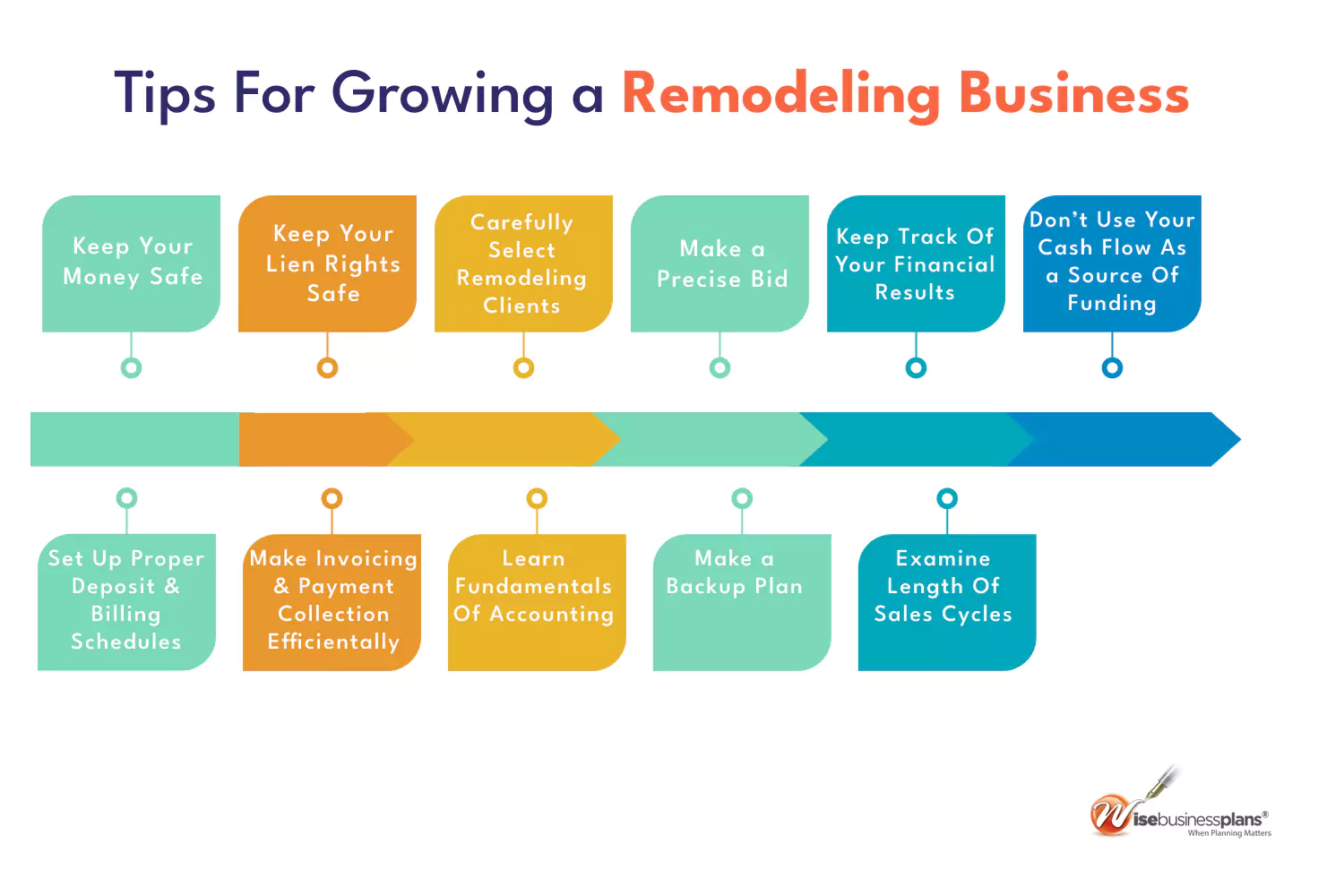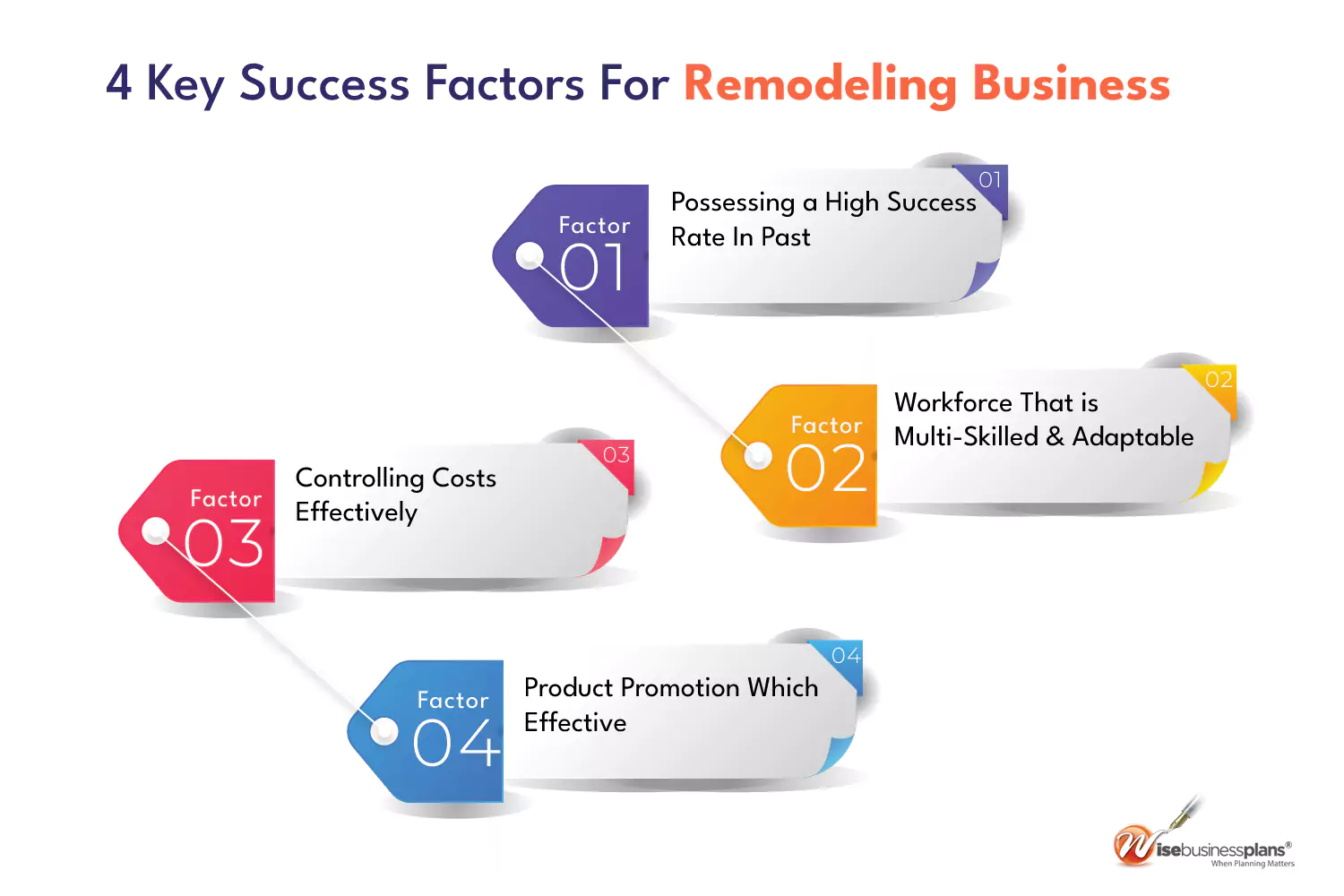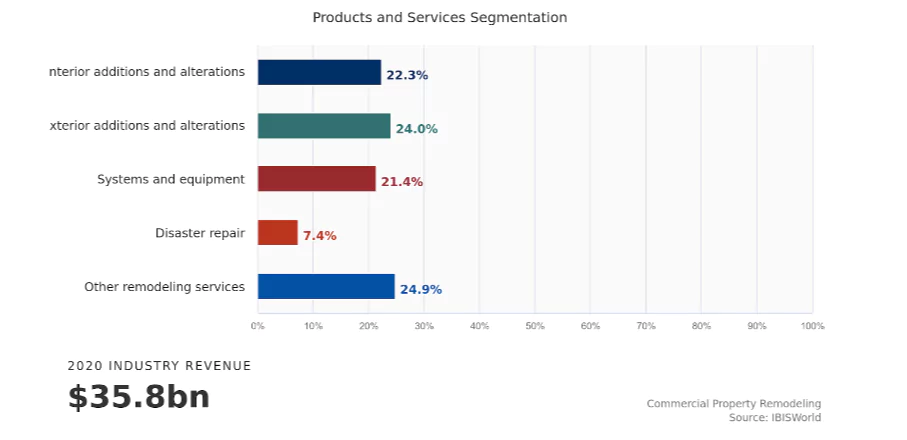How to Start a Remodeling Business
If you're wondering how to start your own home renovation business, this guide on starting a remodeling business is best for you.
Are you considering starting a renovation company but are concerned about the amount of competition? Don’t worry about it.
There’s plenty of opportunity in the remodeling and home renovation world for contractors who accomplish as little as $100,000 in total volume per year and work their way up.
In this article, we’ll go over some of the steps you’ll need to do to get started in the remodeling business.
We’ll also go over some helpful hints for starting and growing a remodeling business in this industry.
So, if you’re considering to change career and becoming a contractor, keep reading!

Step 1. Decide on a specialty
All general contractors specialize in one or two services and then subcontract out the rest of the work. Which services you plan to fulfill yourself and which services you plan to contract out to subs should be addressed in your remodeling business plan.
For example, you may want to start remodeling your kitchen and bathroom, but you will only be able to do the tile work yourself. You’d have to hire others to do the electrical, plumbing, cabinetry, and finishing work. The amount of work you need to sub out will determine how big or small projects you can take on.
Larger projects usually mean more money, but if you have to contract out a lot of work, you may lose more money than you gain.
Step 2: Make a budget plan ahead of time
Home renovation businesses, in contrast to construction businesses, which are typically large corporations, are easier to manage financially. However, don’t expect everything to go smoothly. With so many other entrepreneurs in your field doing the same work as you, the most important thing you can do is make sure you have enough money to cover your initial costs.
This budget should include the wages of your employees (direct labor), overhead expenses (the total cost of all the tools you’ll need to complete the job), and direct materials (pretty self-explanatory). When you’ve figured out all of your upfront costs, it’s time to look into financing options.
Make appointments with several banks to see if they can provide you with some reasonably priced business loans. Additionally, look into government grants for small businesses. Even if you don’t qualify for one right now, knowing what options you have in the future is beneficial.
If you’re just offering your time and skills as a part-time re modeler, the start-up cost will be around $50,000 to $75,000, as you’ll need a full set of tools, a vehicle to transport tools and supplies, and the necessary licencing and insurance to operate in your state and locality. If you are starting a remodeling business providing major renovation services, you’ll need $250,000 to $500,000 in start-up capital, as you’ll need to buy your first few orders of materials and hire staff before your customer pays you for the job.
Step 3: Your remodeling business name
Choosing the right business name is crucial and difficult. If you run a sole proprietorship, you should consider using a different remodeling business name than your own.
When registering a business name, we recommend conducting the following research:
- The business records of your state
- Platforms for social media
- Records of federal and state trademarks
- The availability of a web domain.
Step 4. Create a legal business entity
- LLC
- Sole Proprietor
- C Corporation
- General Partnership
Find out how to form an llc yourself
Learn about llc formation, including information on registered agents, naming rules, business licenses, and more.
Choose Your State to Learn How to Form an LLC There
- Alabama LLC
- Alaska LLC
- Arizona LLC
- Arkansas LLC
- California LLC
- Colorado LLC
- Connecticut LLC
- Delaware LLC
- Florida LLC
- Georgia LLC
- Hawaii LLC
- Idaho LLC
- Illinois LLC
- Indiana LLC
- Iowa LLC
- Kansas LLC
- Kentucky LLC
- Louisiana LLC
- Maine LLC
- Maryland LLC
- Massachusetts LLC
- Michigan LLC
- Minnesota LLC
- Mississippi LLC
- Missouri LLC
- Montana LLC
- Nebraska LLC
- Nevada LLC
- New Hampshire LLC
- New Jersey LLC
- New Mexico LLC
- New York LLC
- North Carolina LLC
- North Dakota LLC
- Ohio LLC
- Oklahoma LLC
- Oregon LLC
- Pennsylvania LLC
- Rhode Island LLC
- South Carolina LLC
- South Dakota LLC
- Tennessee LLC
- Texas LLC
- Utah LLC
- Vermont LLC
- Virginia LLC
- Washington LLC
- West Virginia LLC
- Wisconsin LLC
- Wyoming LLC
Or Make your life easier with Wise Business Plans
Get the easiest and fastest LLC formation online with worry-free services and support.
Step 5. Acquire the required licenses and insurances
You may discover that your state requires you to obtain a contractor’s licence if you Google how to start a remodeling business. You might be able to skip this step if you’re only doing finishing and cosmetic work. If you plan to make any structural changes to homes or buildings, install roofing or siding, or perform electrical or plumbing work, you will need to be properly certified.
In addition, you should purchase general liability insurance. Even if some states don’t require it for all contractors, it’s a good idea to have one in case something goes wrong and the homeowner or business owner decides to blame you.
For example, if you remodel a bathroom and the pipes burst two weeks later, you may be liable for property damage. General liability insurance could protect you from having to pay for a priceless heirloom out of your own pocket if one of your employees steals from a homeowner.
Ready to Protect Your Remodeling Business
Let us help you with your business insurance needs.
- General business liability insurance
- Medical insurance
- Term life insurance
- Workers’ Comp
- Surety bonds
- Commercial auto
Step 6. Make friendship with subcontractors and suppliers
People who provide you with the materials you need for your home renovation business, as well as your collaborators, should be treated as family. Despite the fact that it is a business partnership, it should be built on mutual trust and support.
The most important rule to follow is that you should always pay your suppliers and collaborators on time. Your company will rely on them just as much as it will rely on your own abilities.
For example, you could use online invoicing to speed up the payment process and your company’s workflow. These practical tools not only help with workflow, but they also help with cash flow, resulting in smooth and quick business collaboration. If you need invoice templates, visit our invoice template page to download the professional free invoice templates.
Many new businesses can be found in the home renovation market. While becoming a successful business owner in this field will take a lot of time and effort, there is plenty of room for (both personal and professional) growth. As a result, take the plunge and start your own remodeling business.
Step 7. Create a business bank account and a credit card for it
Personal asset protection necessitates the use of dedicated business banking and credit accounts. When your personal and business accounts are mixed, your personal assets (such as your home, car, and other valuables) are put at risk if your company is sued. This is referred to as piercing your corporate veil in business law.
Furthermore, learning how to build business credit can help you obtain business credit cards and other financing in your business’s name (rather than your own), lower interest rates, and increase credit lines, among other benefits.
Open a bank account for your business
- Separates your personal assets from your company’s assets, which is necessary for personal asset protection.
- Makes accounting and tax filing easier.
Create a net 30 account
Get a credit card for your remodeling business
- Put all of your business expenses in one place to separate personal and business expenses.
- Build your company’s credit history, which will come in handy if you need to raise money in the future.
Step 8. Set up a phone system for your business
Getting a business phone is one of the most effective ways to keep your personal and professional lives separate and private. That isn’t the only advantage; it also aids in the automation of your business, provides legitimacy to your company, and makes it easier for potential customers to locate and contact you.
Wise business plans offer a variety of features for businesses, including Toll-free numbers, Coverage in US and Canada, team messaging and more. Try our business phone services today.
Step 9: Promote your expertise
Your company will require excellent marketing in order for people to be aware of and use the services you provide. One of the things you should do in the first few months of your remodeling business is market it.
You can advertise your business by handing out flyers, putting up billboards, or using the internet. Putting your brand on Craigslist is the best way to market today. You’ll get more leads and make more money if you use online marketing.
Tips for Growing a Remodeling Business

Here are some tips for contractors on how to handle increased demand and expand their remodeling business during a recession.
1. Keep your money safe
2. Keep your lien rights safe
3. Carefully select remodeling clients
4. Make a precise bid
5. Keep track of your financial results
6. Don’t use your cash flow as a source of funding
7. Set up proper deposit and billing schedules
8. Make invoicing and payment collection more efficient
9. Learn the fundamentals of accounting
10. Make a backup plan
11. Examine the length of your sales cycles
4 Key success factors

- Possessing a high success rate in the past (including completed prior contracts): Companies with a strong reputation for having the financial, managerial, and technical capacity for remodeling projects attract potential clients. Successful remodeling companies can show a portfolio of previous work and testimonials from happy clients.
- Workforce that is multi-skilled and adaptable: Reputable tradespeople and subcontractors are available on a project-by-project basis for successful remodeling companies.
- Controlling costs effectively: Successful remodeling businesses maintain tight cost controls and have access to low-cost input materials to maintain competitive pricing.
- Product promotion which effective: To generate publicity and new contracts, successful remodeling companies have a strong marketing department.
The highlights of our recently developed remodeling business plan
Market Analysis Summary: Remodeling Business Plan
Over the five years to 2020, operators in the Commercial Property Remodeling industry have benefited from increased demand as a result of falling office rental vacancy rates and rising consumer spending, at least through 2019.
Furthermore, in recent years, rising corporate profits have prompted businesses to renovate commercial properties, boosting demand for industry services.
As a result, IBISWorld expects industry revenue to grow at a 4.4% annualized rate to $35.8 billion over the forecast period. However, the spread of COVID-19 (corona virus) has brought the global economy and, with it, industry activity to a halt in 2020.
Industry revenue is expected to fall in 2020 due to expected decreases in the value of private nonresidential construction and corporate profit. At the same time, due to the rise in stay-at-home orders, office rental vacancies have increased. As a result, revenue growth is expected to slow by 11.3% in 2020.


Product and Services
Interior room additions and alterations will account for 22.3 percent of industry revenue in 2020, according to industry contractors. Interior room alterations and additions are required for all downstream markets, including office buildings, commercial buildings, and other structures.
When businesses relocate, commercial property contractors, for example, renovate their office interiors. Removing walls, doors, and other interior infrastructure can also help industry operators expand warehouses and other facilities.
Over the last five years, demand for interior alterations and additions has risen in tandem with a rise in commercial construction spending.

Frequently Asked Questions
You’ll need to keep track of your material suppliers’ accounts, pay your crews on time, and keep your vehicles and tools in good working order. Fortunately, you can keep your office space to a minimum.
Owners of residential and commercial properties who want their property professionally renovated and are willing to pay a reasonable price for labor and materials. Large businesses that require renovations may have more space, allowing you to charge a higher rate.
Customers pay you for labor and materials for their renovation, which is how your remodeling business makes money. As part of your trade, you are responsible for providing your own tools. Paint, hardware, lumber, flooring, and other supplies, on the other hand, are purchased at wholesale prices and then charged to your customer at a premium. Your hourly labor costs will be determined by your level of expertise, the type of job you’re doing, and local labor rates.
The size and complexity of the job will determine your rates. Rates range from $45 to $85 per hour, with the possibility of lower or higher rates. To ensure that your client is getting a good deal, you should conduct a thorough competitive analysis. Between $3,000 and $15,000 is the average cost of a renovation project.
The standard markup on materials is 15%. A one-man company with multiple crews can earn around $20,000 per year working part-time, while a large contractor with multiple crews can earn in the seven figures when they complete multiple large jobs throughout the year.
Providing high-quality work that completely satisfies your customers is the most effective way to increase business and profit. For a successful remodeling business, you’ll need to make sure that quality control and customer service are always top priorities.
Get in Touch
Contact Us Today For A Free Consultation
Related Articles
- Business Planning
- Bank Business Plan
- Investor Business Plans
- Franchise Business Plan
- Strategic Business Plan
- M&A Business Plan
- Private Placement
- Feasibility Study
- Pitch Deck
- Pitch Deck
- Market Research
- Sample Business Plans
- Hire a Business Plan Writer
- Business Plan Printing
- Business Valuation Calculator
- Business Plan Examples
- Real Estate Business Plan
- Business Plan Template
- Business Plan Pricing Guide
- Nonprofit Business Plan
- Business Plan Makeover
- Business Funding
- Business E-learning Series
- Business Assets

Proud Sponsor of
- 1-800-496-1056

- (613) 800-0227

Quick Links


Business Planning
- Bank Business Plan
- Investor Business Plans
- Franchise Business Plan
- Strategic Business Plan
- M&A Business Plan
- Private Placement
- Feasibility Study
- Pitch Deck Business Plan
- Pitch Deck
- Market Research
- Sample Business Plans
- Hire a Business Plan Writer
- Business Plan Printing
- Business Valuation Calculator
- Business Plan Examples
- Real Estate Business Plan
- Business Plan Template
- Business Plan Pricing Guide
- Nonprofit Business Plan
- Business Plan Makeover
Business Funding
Business E-learning Series
Business Assets
Business Building
Compliance
Immigration Business Plans
Business Partners







